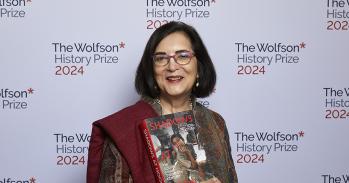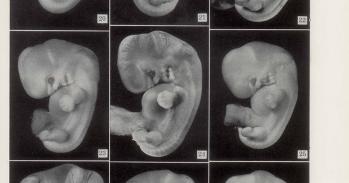
A remarkable archive records the purchases made by William Courten (1642–1702) whose museum was praised by visitors as a noble collection of curiosities. An investigation of Courten’s records by Dr Sachiko Kusukawa reveals that Courten bought items from more than 80 individuals, many of them trading within walking distance of his rooms in London’s Middle Temple.
A remarkable archive records the purchases made by William Courten (1642–1702) whose museum was praised by visitors as a noble collection of curiosities. An investigation of Courten’s records by Dr Sachiko Kusukawa reveals that Courten bought items from more than 80 individuals, many of them trading within walking distance of his rooms in London’s Middle Temple.
If you examine Courten’s accounts – which exist for the years 1689 to 1693 – you get a picture of a thriving trade in objects which were purchased by Courten from a large number of individuals who lived or worked within walking distance of his rooms in Middle Temple.
Sachiko Kusukawa
On 9 June 1689 a man in his late 40s named William Courten bought the following items from Mrs Alley in Upper Shadwell (East London): 1 sea fowle, 1 cap of seafowles skin, 1 young Pelican, 1 Large Starfish of ye wreck, 1 smaller starfish of ye wreck, 1 sawfishes saw, 1 East India Coconut, 1 branch of pine from Norway, 1 Large concha veneris, 2 Small concha veneris.
Courten, who was an ambitious collector, went on to buy items from at least three other Londoners that same day. The list of his purchases, each of which is accompanied by a price, makes intriguing reading for scholars seeking to understand the nature and mechanisms of 17th-century collecting. It was collections such as Courten’s that laid the foundations for some of Britain’s best known institutions – including the British Museum, British Library and Natural History Museum.
As a specialist in the production of knowledge in the early modern period, Cambridge University historian Dr Sachiko Kusukawa is particularly interested in the marketplace for curiosities, tracing the routes by which items passed from hand to hand and for how much, to try to build a picture of the networks and infrastructure that underpinned interests in natural and antiquarian objects.
It is thought that Courten’s museum opened its doors for the first time in 1684 at Middle Temple. As its owner and, most probably its sole curator, Courten was known to be generous in showing and sharing his collection. Writing in 1695, Ralph Thoresby recorded in his diary that Courten’s museum “is perhaps the most noble collection of natural and artificial curiosities, of ancient and modern coins and medals, that any private person in the world enjoys; it is said to have cost him 7,000 or 8,000 pound sterling”.
Courten was part of a milieu that included the naturalists John Ray and Francis Willughby and the diarist John Evelyn. When Courten died in 1702 his collections were passed, as his will stipulated, to his friend Hans Sloane, a fellow collector and physician whose collection provided the foundations for the British Museum.
Although tantalisingly little has been passed down as a record of his museum, Courten’s accounts of his purchases (meticulously recorded in his own neat hand) survive in the extensive Sloane papers which are held by the British Library.
“If you examine Courten’s accounts – which exist for the years 1689 to 1693 – you get a picture of a thriving trade in objects which were purchased by Courten from a large number of individuals who lived or worked within walking distance of his rooms in Middle Temple. He mentions many of them by name – quite a few were women – and some of the names crop up several times,” said Kusukawa.
An investigation of Courten’s accounts for 1689-93 by Kusukawa reveals that he purchased hundreds of objects from more than 80 named individuals as well as from a smaller number of people described simply in terms of their jobs (a barber at the Hermitage, a Dutch Doctor of the East Indian Ship) or trading spots (at the sign of the coffin in Watling Street, in Milke Alley).
Kusukawa has so far been able to identify around a dozen of the individuals named by Courten. They include John Lloyd, the London print publisher, Edward Lhuyd, the Keeper of the Ashmolean, the philosopher John Locke and Hans Sloane. Further research may reveal more details of other people from whom Courten bought objects or, in the case of other collectors, engaged in exchanges.
She said: “A fascinating aspect of Courten’s records is the listing of the price paid, or asked for, for each of the objects. This gives us a picture of perceived value. The surviving archive relating to Sloane’s collection, by contrast, contains very little information on monetary transactions which suggests that there may well have been a deliberate removal of papers relating to finance.”
Courten (also known as Charleton) was a collector with an extensive museum in his rooms in Middle Temple devoted to displays of natural, ethnographical and antiquarian objects. A reference to Courten’s headaches, which prompted him to resolve not to accept visitors on consecutive days, suggests that he often received guests on a daily basis.
Kusukawa’s reading of Courten’s accounts suggests that a dizzying diversity of curiosities was on display. Painstakingly described by Courten, they range from a “stone taken out of a man’s bladder” and a “Verry fine Tokan beak” to a “Very pretty small dunish fly with dark browne spots on ye wings & red and green on ye body” and (purchased from Mr Partridge, possibly a goldsmith) “Penis & Testicles of crocodile”.
So detailed are Courten’s notes of his purchases that some of the objects he bought may be traced. A “goose R[oman god found] at Pauls” is to be found today in the collections of the British Museum and “2 pcs of teeth of an Elephant found neare by ye Pinard of Wakefield (a pub on Gray’s Inn Road) in a Ditch” are almost certainly mammoth teeth that were discovered alongside the (lower paleolithic) flint-axe in 1679 by John Conyers.
Courten was a keen collector of prints, and he valued Albrecht Duerer’s print of Adam and Eve, for example, as worth £2. But by far the most costly items that appear in Courten’s accounts are paintings on vellum by Guillaume Toulouze, a master embroiderer at Montpellier whom Courten must have met when he was staying there. A purchase of 17 drawings of natural objects by Toulouze came to £550, and with glass frames, a total of £690 pounds. One picture ‘vipers and lizards’, for example, cost £75, glass for the frame £11, and the frame itself £5.
These are substantial sums but little is known about how Courten funded his collection. He came from a wealthy family (his grandfather acquired and then lost a huge fortune by investing in Barbados) which had experienced a dramatic downturn in fortunes, and his father was involved in a slew of lawsuits. Courten seems to have brokered a deal whereby he dropped claims on his family fortune, which may be the reason why he changed his name to Charleton.
“It’s possible that Courten sought to disassociate himself from these financial wranglings and make his mark as a man of culture, sharing his collection with scholars and visitors,” said Kusuwara.
“Courten’s lists may well help with the provenance of surviving objects in the British Museum, but they also raise larger questions about the economics of collecting in late 17th-century England, and the infrastructure that supported it. The contacts listed in his lists suggest a wide and vibrant circulation of natural, ethnographical and antiquarian objects, a social circulation of nature that deserves further research.”
Inset images: Cabinet of Curiosities at National Geographic Museum, City of London Ogilby and Morgan's Map of 1677, Interior of a London Coffee-House, 17th century (all Wikimedia Commons). Portrait of William Courten as a younfg man, Roman bronze goose (both British Museum).
The text in this work is licensed under a Creative Commons Licence. If you use this content on your site please link back to this page. For image rights, please see the credits associated with each individual image.





